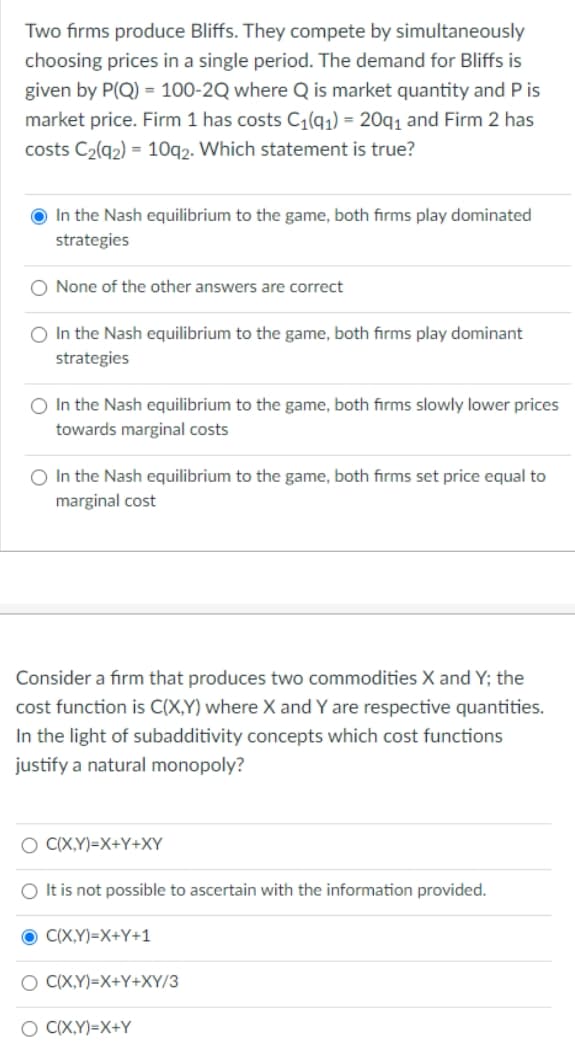Two firms produce Bliffs. They compete by simultaneously choosing prices in a single period. The demand for Bliffs is given by P(Q) = 100-2Q where Q is market quantity and P is market price. Firm 1 has costs C1(q1) = 20q1 and Firm 2 has costs C2(q2) = 10q2. Which statement is true? %3D
Two firms produce Bliffs. They compete by simultaneously choosing prices in a single period. The demand for Bliffs is given by P(Q) = 100-2Q where Q is market quantity and P is market price. Firm 1 has costs C1(q1) = 20q1 and Firm 2 has costs C2(q2) = 10q2. Which statement is true? %3D
Chapter15: Imperfect Competition
Section: Chapter Questions
Problem 15.4P
Related questions
Question
Please answer fast in both

Transcribed Image Text:Two firms produce Bliffs. They compete by simultaneously
choosing prices in a single period. The demand for Bliffs is
given by P(Q) = 100-2Q where Q is market quantity and P is
market price. Firm 1 has costs C1(q1) = 2091 and Firm 2 has
costs C2(q2) = 1092. Which statement is true?
In the Nash equilibrium to the game, both firms play dominated
strategies
O None of the other answers are correct
O In the Nash equilibrium to the game, both firms play dominant
strategies
O In the Nash equilibrium to the game, both firms slowly lower prices
towards marginal costs
O In the Nash equilibrium to the game, both firms set price equal to
marginal cost
Consider a firm that produces two commodities X and Y; the
cost function is C(X,Y) where X and Y are respective quantities.
In the light of subadditivity concepts which cost functions
justify a natural monopoly?
O CX,Y)=X+Y+XY
O It is not possible to ascertain with the information provided.
O C(X,Y)=X+Y+1
O C(X,Y)=X+Y+XY/3
O CX,Y)=X+Y
Expert Solution
This question has been solved!
Explore an expertly crafted, step-by-step solution for a thorough understanding of key concepts.
Step by step
Solved in 3 steps

Knowledge Booster
Learn more about
Need a deep-dive on the concept behind this application? Look no further. Learn more about this topic, economics and related others by exploring similar questions and additional content below.Recommended textbooks for you


Principles of Microeconomics (MindTap Course List)
Economics
ISBN:
9781305971493
Author:
N. Gregory Mankiw
Publisher:
Cengage Learning

Managerial Economics: A Problem Solving Approach
Economics
ISBN:
9781337106665
Author:
Luke M. Froeb, Brian T. McCann, Michael R. Ward, Mike Shor
Publisher:
Cengage Learning


Principles of Microeconomics (MindTap Course List)
Economics
ISBN:
9781305971493
Author:
N. Gregory Mankiw
Publisher:
Cengage Learning

Managerial Economics: A Problem Solving Approach
Economics
ISBN:
9781337106665
Author:
Luke M. Froeb, Brian T. McCann, Michael R. Ward, Mike Shor
Publisher:
Cengage Learning

Managerial Economics: Applications, Strategies an…
Economics
ISBN:
9781305506381
Author:
James R. McGuigan, R. Charles Moyer, Frederick H.deB. Harris
Publisher:
Cengage Learning


Exploring Economics
Economics
ISBN:
9781544336329
Author:
Robert L. Sexton
Publisher:
SAGE Publications, Inc